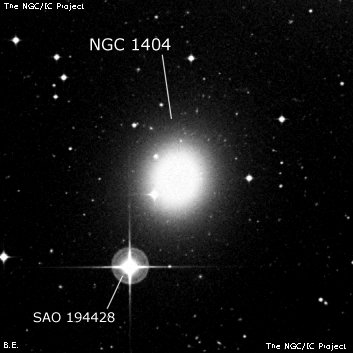
John Herschel discovered NGC 1404 = h2571 on 28 Nov 1837 and recorded (the following night) "vB, R, psmbM, 40", has a star N.f." His RA was 12 seconds too large and the star is south following but this identification is certain. In 1865 Julius Schmidt measured a more accurate position with the 6.2" refractor at the Athens Observatory, though he initially reported it as a new nebula. His later table in 1876 correctly identifies it as h2571.
200/250mm - 8" (10/13/81): fairly bright, small, round, bright core. A mag 8 star is close SSE.
300/350mm - 13.1" (12/22/84): bright, fairly small, round, bright core. Located just 2.8' NNW of mag 8.1 SAO 194428. NGC 1399 lies 10' NW. Member of Fornax I cluster.
400/500mm - 18" (12/17/11): very bright, moderately large, round, 1.5' diameter. The outer halo gradually increases then brightens fairly rapidly to a small, very bright core. The core increases to the center but a stellar nucleus wasn't seen. A mag 12-12.5 star is 45" SE, at the edge of the halo. Mag 8.1 HD 22862 lies 2.8' SE. NGC 1404 is smaller but has an overall higher surface brightness than NGC 1399, located 10' NNW. NGC 1396 lies 4.6' W.
At 285x, supernova 2011iv, discovered on Dec 2, was easily visible just 7" W and 8" N of center. The supernova was similar in brightness to the mag 12-12.5 star at or just off the southeast edge of the halo.
Notes by Steve Gottlieb